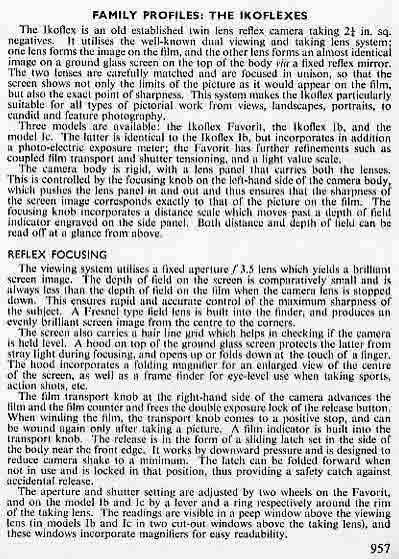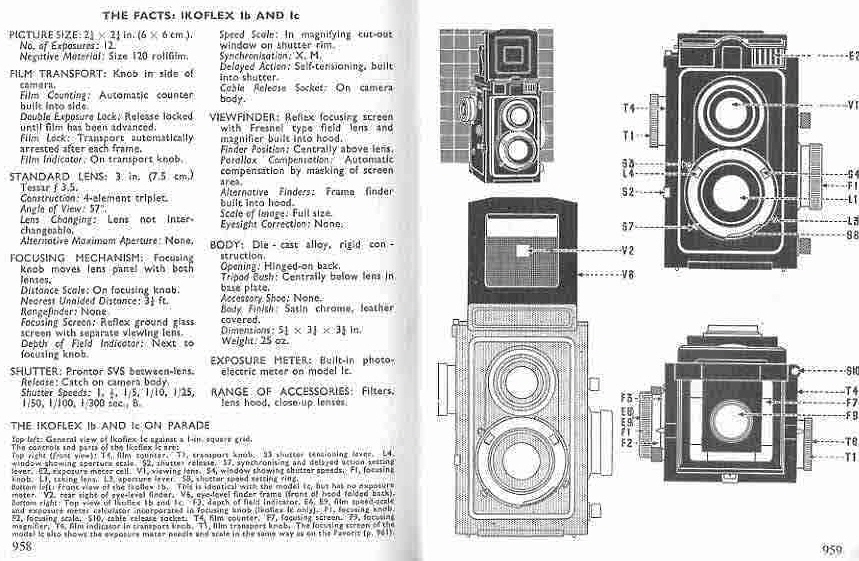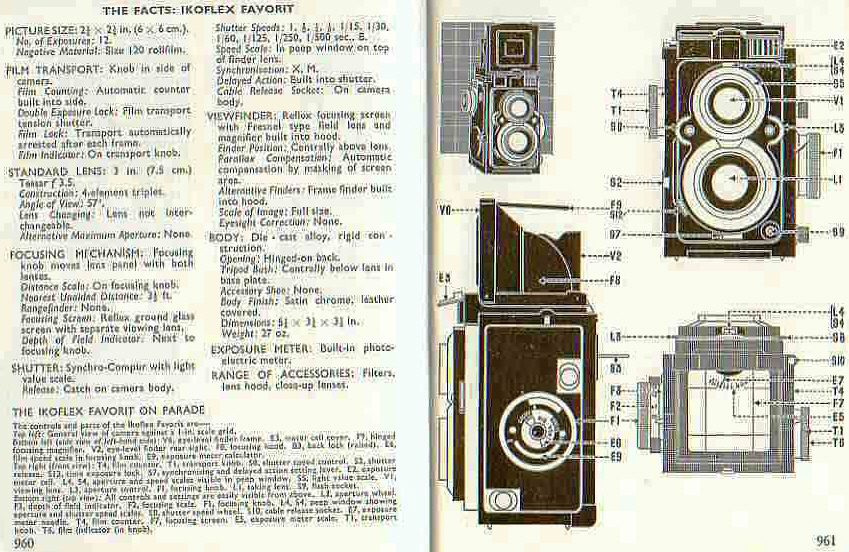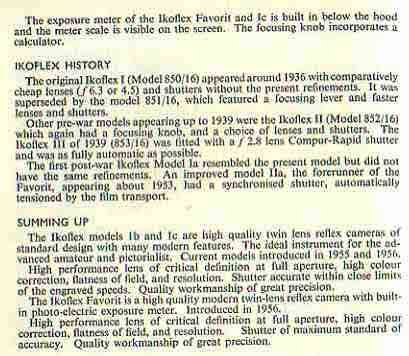.JPG)
Ikoflex I 850-16 (early)
The original Ikoflex I and II were launched simultaneously to replace the Coffeecan in 1936-7. This early and basic one has a Novar lens. Lever focus on right side (changed to knob from 1938).
Taking lens is Novar 80mm f4.5
Shutter is a Klio 1 - 1/175 sec
|

Ikoflex II 851/16
The year-younger model II - very similar to the I - is somewhat improved. A considerably better shutter/lens, and the oval Art Deco lens surround has changed from black to chrome.
Taking lens is Triotar 75mm f3.5
Shutter is Compur-Rapid 1-1/500
|

Ikoflex II/III 852/16
Evolved from the Ikoflex II above in 1938. Aperture/speed now in peepholes overviewing lens. Came out as Ikoflex III, but soon renamed as new III launched.
Taking lens is Triotar 75mm f3.5
Shutter is Compur 1 to 1/300
|
.JPG)
Ikoflex II/III (brass) 852/16
Same model as previous one, but this one has an unusual brass nameplate - probably it has been over-polished and the chrome removed, or perhaps the plating was poor-quality on this one.
Taking lens is Triotar 75mm f3.5
Shutter is Compur 1 to 1/300
|

Ikoflex III 853/16
From 1939: widely seen as the best Ikoflex of all. Crank advance and shutter cocking. Huge mirrored Albada sport finder on hood. Grey leathercloth finish.
Taking lens is Tessar 80mm f2.8
Shutter is Compur-Rapid 1 to 1/400
|

Ikoflex I 850/16
From 1939: replaced old Ikoflex II, confusingly. Made until 1951 under different managements. Body design changed, but carcass did not.
Taking lens is Novar 75mm f3.5
Shutter unnamed, prob. Klio 1 to 1/250
|
 855-16.JPG)
Ikoflex IIa (early) 855/16
Developed from the Ikoflex II, but with new front housing design. Speed and aperture are shown in two peepholes bracketing the taking lens.
Taking lens is Tessar 75mm f3.5
Shutter Compur-Rapid 1 to 1/500
|
 855-16.JPG)
Ikoflex IIa (late) 855/16
Fussy frontal design prefigures Favorit (below). Speed/aperture set by wheels, show in single window over taking lens. Exposure meter. "Ikoflex" under lens.
Taking lens is Tessar 75mm f3.5
Shutter Synchro-Compur MX 1 to 1/500
|

Ikoflex Ia 854/16
First postwar series I 1956. Black nameplate, silver letters. Retains top-mounted shutter push-button. Aperture/speed windows by taking lens.
Taking lens is Novar 75mm f3.5
Shutter unnamed (Prontor-SV) 1 to 1/300
|

Ikoflex Ib 856/16
Improved Ia 1956. Similar looks, but folding side shutter release. Hood folds in one action. Aperture/speed in magnified windows by the taking lens.
Taking lens is Tessar 75mm f3.5
Shutter unnamed (Prontor-SVS) 1 to 1/300
|

Ikoflex Ic 886/16
The final series I model, produced from 1956. It has a CdS meter where the nameplate would have been, like the late IIa above, with the readout projected into the viewfinder - a nice refinement carried over to the Favorit. A distinct notch above the Ib, and prices today indicate that it still has a fond following.
Taking lens is Tessar 75mm f3.5
Shutter unnamed (Prontor-SVS) 1 to 1/300
|

Ikoflex Favorit 887/16
Sometimes known by cognoscenti as the "IIc", the Favorit was the last of a great line. It has cross-coupled light-value setting for aperture and speed, set by wheels, like the late IIa (above). The built-in LVS meter is projected on the viewfinder ground glass. Winding the film on auto-cocks the shutter. This particular one is a very nice camera, found in a school cupboard in US Mid-West, near-unused and with some Zeiss accessories.
Taking lens is Tessar 75mm f3.5
Shutter Synchro-Compur MXV 1 to 1/500
|





